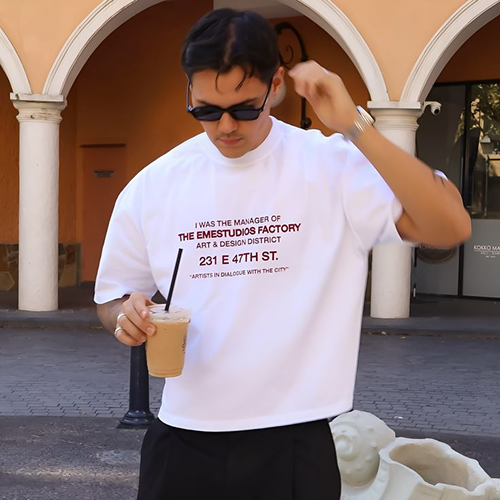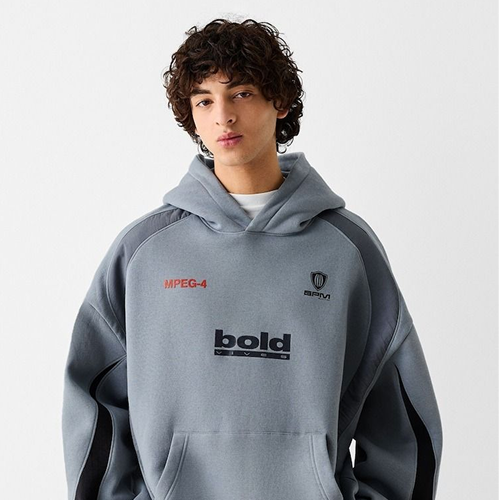Fashion today isn’t just about what looks good — it’s about what feels true. And few garments reveal our true selves better than the humble T-shirt and hoodie. What started as workwear and athletic gear has become a form of language — a visual vocabulary that expresses individuality, culture, and belonging.
This is the story of how two of the simplest garments in history came to define the complexity of modern identity.
I. Origins of a Revolution
- The Birth of Everyday Icons
The T-shirt began as an undergarment — a practical, invisible layer beneath uniforms. The hoodie was invented for cold warehouses in the 1930s, designed to keep workers warm.
Neither was meant to be fashionable. Yet, both evolved into something far greater.
By the 1950s, Hollywood rebel icons like Marlon Brando and James Dean transformed the T-shirt into a symbol of youth rebellion. In the 1970s and 80s, the hoodie became synonymous with street culture, hip-hop, and athletic freedom.
Together, they marked the rise of casual individuality — clothing that said, “I am who I am.”
- Fashion Democratized
Before the T-shirt and hoodie, fashion was about class and hierarchy. After them, it became about access.
Anyone could wear a tee. Anyone could own a hoodie.
And in that universality, they became the most democratic garments on earth.
This accessibility is precisely why they became powerful cultural tools — vehicles for art, identity, and self-expression.
II. The Language of Simplicity
- Why Minimalism Resonates
A plain white T-shirt is paradoxical. It’s nothing — and everything.
Its simplicity strips away distractions, forcing the focus onto the person wearing it.
In fashion psychology, this is called “the blank canvas effect.”
When we remove excess, authenticity shines.
That’s why minimal garments like hoodies and tees feel timeless — they allow identity to breathe.
- The Hoodie’s Dual Identity
The hoodie’s power lies in its ambiguity. It can hide you or highlight you.
It can be the uniform of protest, or of peace.
In its drape and hood, there’s a quiet defiance — the right to exist comfortably, unapologetically.
It’s no coincidence that both activists and artists have embraced it. From Trayvon Martin’s tragic symbolism to Kanye West’s oversized silhouettes, the hoodie has become a statement of both vulnerability and power.
III. Crafting Character Through Fabric
- Material as Personality
The tactile experience of a tee or hoodie tells you something about its wearer.
Heavy cotton signals permanence and confidence.
Lightweight jersey feels open and relaxed.
French terry suggests subtle luxury.
Organic fleece speaks of consciousness and care.
Designers today use these materials to build emotional resonance. When you wear a piece that feels right, you align with your internal rhythm.
- The Power of Fit
Fit transforms energy. A boxy hoodie conveys ease and creative nonchalance.
A tailored tee shows intentionality and awareness.
Oversized silhouettes feel youthful and free; cropped or slim fits suggest discipline.
We read each other through these shapes — subconsciously decoding personality from proportion.
IV. The Social Identity of Casualwear
- Streetwear’s Rise as Modern Uniform
Streetwear redefined luxury. What once belonged to runways now thrives on sidewalks.
And the T-shirt and hoodie became the foundation of that aesthetic — blank stages for cultural exchange.
Today, streetwear isn’t “anti-fashion.” It is fashion.
The difference lies in energy: it’s driven by community, not couture.
Logos like Supreme, Stüssy, and Off-White transformed everyday basics into collectible art pieces.
- Subculture to Global Language
Every generation has used the hoodie and tee to express rebellion.
The punk movement spray-painted them.
Hip-hop culture oversized them.
Skate and surf communities thrashed them.
Tech culture simplified them.
Now, Gen Z fuses them all — combining vintage graphics, sustainability, and high-end comfort into one seamless identity.
The message is clear: your hoodie isn’t just a garment. It’s a worldview.
V. The Emotional Weight of Everyday Wear
- Nostalgia in Threads
We keep old tees for a reason.
A faded band print or a stretched neckline carries stories.
That worn-out hoodie from college? It’s memory in fabric form.
Fashion psychologists call this emotional durability — the bond between object and experience.
Unlike fast fashion, these items become part of your timeline.
- The Comfort of Repetition
Wearing something familiar gives psychological safety.
That’s why creatives, CEOs, and even stylists often wear the same basics every day — it reduces decision fatigue and builds identity consistency.
Mark Zuckerberg’s gray hoodie, Steve Jobs’ black turtleneck, and Virgil Abloh’s white tee all communicate clarity through repetition.
VI. The Future of Basic Luxury
- The Quiet Revolution of Quality
The new luxury isn’t about logos. It’s about longevity.
High-quality tees and hoodies made from organic pima cotton or recycled yarns reflect a deeper understanding of consumption.
Instead of chasing trends, the modern consumer seeks stability — pieces that age well, adapt, and endure.
In an unstable world, lasting fabric becomes emotional armor.
- Sustainability and Digital Connection
Technology is reshaping fashion’s foundation.
Blockchain can verify garment origins. AI can design personalized fits. Circular production keeps hoodies and tees in ethical cycles.
But even as fashion digitizes, comfort remains analog.
The weight of cotton, the smell of clean fleece — these are timeless human sensations.
VII. Beyond Gender, Beyond Seasons
Hoodies and tees have transcended categories. They are not male or female, summer or winter — they’re human.
This universality defines the new era of design: fluidity over formality.
Genderless collections, modular fits, and adaptive silhouettes are now the future.
It’s not about who wears it. It’s about how it feels when worn.
VIII. The Aesthetic of Honesty
The most powerful aspect of the T-shirt and hoodie is how they invite authenticity.
You can’t fake comfort. You can’t hide personality in simplicity.
Every stain, wrinkle, or stretch tells truth.
That’s why the world’s most photographed people still choose them. They feel real.
Conclusion: The Fabric of Identity
The T-shirt and hoodie are not just clothes — they’re mirrors.
They reflect how far we’ve come as a culture, and how far we want to go.
They symbolize a quiet rebellion against performance, choosing peace over pretense.
They remind us that style isn’t a costume — it’s an extension of self.
And as long as comfort continues to lead culture, these two pieces will remain the backbone of modern fashion — timeless, adaptable, and profoundly human.



